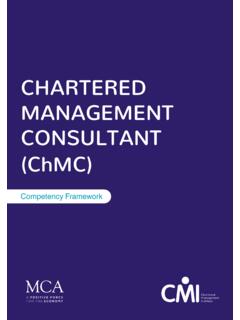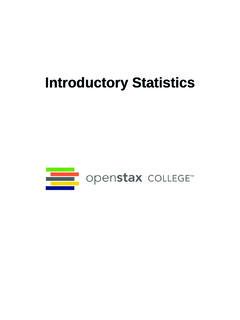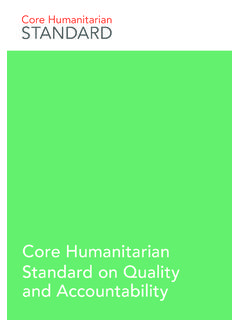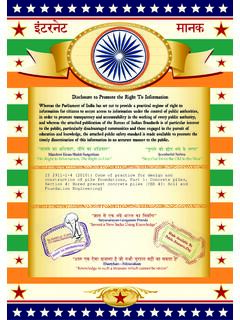Transcription of Office of Justice Programs National Institute of Justice
1 Department of Justice Office of Justice Programs National Institute of Justice National Institute of Justice R e s e a r c h i n B r i e f Julie E. Samuels, Acting Director May 2000. Issues and Findings Police Attitudes Toward Abuse Discussed in this Brief: The of Authority: Findings From Police Foundation's nationally representative telephone survey of 925 randomly selected American a National Study police officers from 121 depart- ments explores the officers' views By David Weisburd and Rosann Greenspan with Edwin E. Hamilton, Hubert Williams, on the abuse of police authority. and Kellie A.
2 Bryant Officers also provided information on different forms of abuse they Serious cases of abuse of police authority Foundation a nonprofit organization in have observed, the frequency of often stimulate intense public debate. Washington, , that seeks to improve abuse in their departments, and For example, a videotape of Rodney policing in America through research . effective strategies for controlling King being beaten by Los Angeles police surveyed a representative National sample abuse. General findings, as well as differing attitudes of black, white, officers or reports of the torture of Abner of American police officers to explore and other minority officers, are pre- Louima by New York City police capture their attitudes on the abuse of authority sented and discussed in this Brief.
3 The public's attention and raise troubling by police (see Study Methodology ). The questions regarding the limits of legiti- survey sought to determine whether offic- Key issues: Unlike previous studies on the abuse of police authority, mate police authority in a democratic ers view abuse of authority as an inevi- this survey provides a nationwide society. Are such events isolated occur- table byproduct of increased efforts to portrait of how police officers view rences in particular police departments control crime and disorder. It also asked this critical issue. The 92-question or extreme examples of a more general what forms of abuse exist, how common survey assessed American police problem plaguing police departments abuse of authority is, and what strategies officers' views on a number of important issues relating to the across the United States?
4 Does the fact and tactics would be most effective in pre- abuse of police authority in the that such abuses often involve minority venting police from abusing authority. The United States: victims reveal important disparities in the survey also considered how community- way that law enforcement officers treat oriented policing has affected officers' at- Whether officers believe that the abuse of police authority is a members of certain racial, socioeco- titudes on abuse of authority and the rule necessary byproduct of efforts to nomic, or cultural groups? In turn, what of law. In particular, it explored whether reduce and control crime.
5 Measures can be taken to constrain po- community policing has led police to show lice abuse, and which are likely to be greater respect for the rights of citizens or, What types of abuse and attitudes toward abuse officers most effective? Although such questions conversely, has increased the potential for observe in their departments. have been raised and debated in the me- police abuse and encouraged police offic- Within this broad issue, the survey dia, by politicians, and by police scholars ers to expand the boundaries of accept- explores officers' views on the code and administrators, little is known about able use of police authority.
6 Of silence, whistle blowing, and how police officers themselves view these the extent to which a citizen's Relatively few surveys of police attitudes demeanor, race, or class affects critical issues. toward abuse of authority have been con- the way that he or she is treated by police. With the support of the Office of Com- ducted, and these have focused primarily munity Oriented Policing Services, on specific police agencies or local or What strategies or tactics Department of Justice , the Police State Some of these studies (including first-line supervision, community policing, citizen review boards, and training) officers continued.
7 R e s e a r c h i n B r i e f Issues and Findings yield important insights regarding the departments or regions of the country. continued problem of police abuse of authority. Results of the Police Foundation's study, Studies conducted across two midwestern by contrast, are based on a telephone sur- find to be effective means of preventing officers from abusing States (one in Illinois and one in Ohio), vey of a representative National sample of authority. for example, suggest that a significant more than 900 American police officers. minority of police officers have observed Their responses provide the first National The survey also analyzed responses police using considerably more force portrait of police attitudes toward the according to the participants' race, rank, and sex.
8 Than necessary when apprehending a sus- abuse of authority. pect. In the Illinois study, more than 20. Key findings: The results of the percent of the officers surveyed reported survey indicate that the majority of General findings having observed this type of abuse2; in American police officers believe Overview of findings. The use of force that: the Ohio study, 13 percent of respondents had seen such Moreover, both is a relatively rare occurrence in Ameri- It is unacceptable to use more studies suggest that police harassment of can policing,4 but previous studies sug- force than legally allowable to minorities is not an isolated occurrence.
9 Gest that when it does occur, it may often control someone who physically escalate to the level of excessive force. assaults an officer. More than 25 percent of officers surveyed in the Illinois study and 15 percent of For example, a 1996 reexamination of Extreme cases of police abuse of those in the Ohio study stated that they 5,688 cases in the 1977 Police Services authority occur infrequently. had observed an officer harassing a citi- Study data found that reasonable force zen most likely because of his or her was used in 37 cases ( percent) and Their departments take a tough stand on the issue of police abuse.
10 Race. that improper force was used in 23 cases ( percent).5 Therefore, improper force At times their fellow officers use Prior studies such as these provide was used in 38 percent of encounters that more force than necessary when suggestive findings on police officers' involved force. As the author of that study, making an arrest. attitudes toward the abuse of authority. Robert Worden, stated, [I]ncidents in It is not unusual for officers to Nonetheless, the conclusions that may which improper force was used represent ignore improper conduct by their be drawn from them are limited by the a substantial proportion of the incidents fellow officers.















